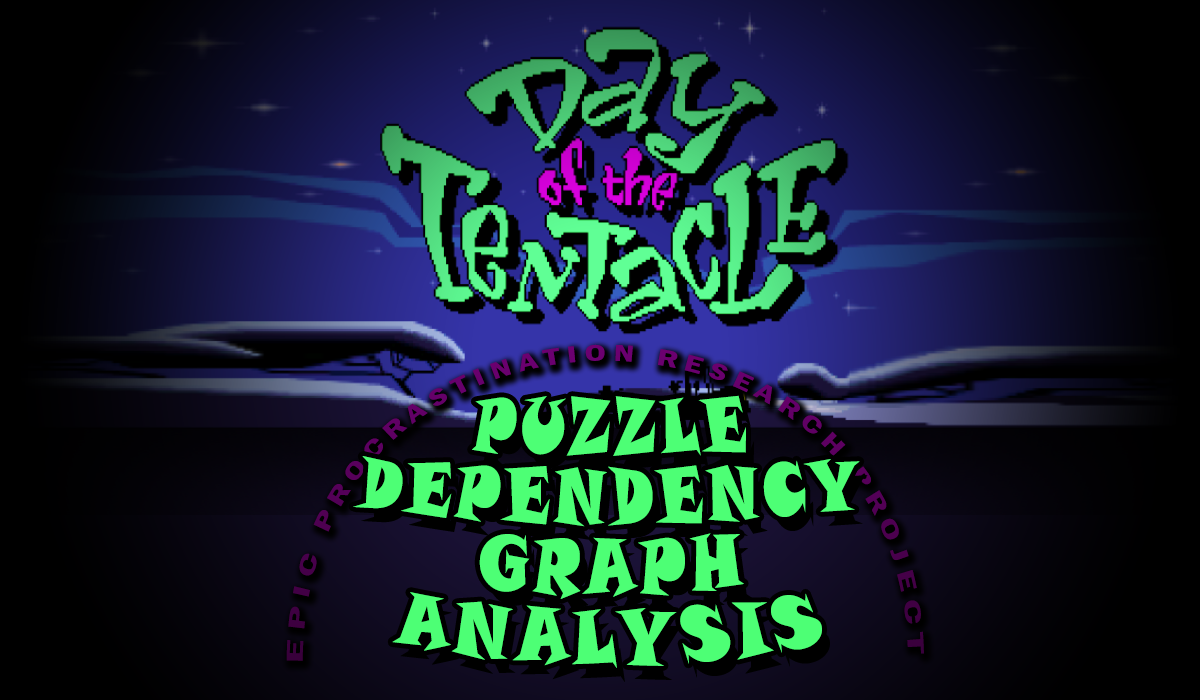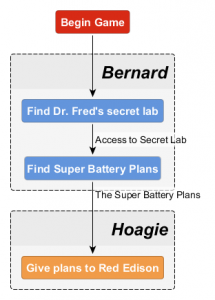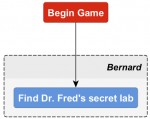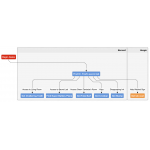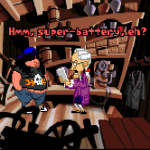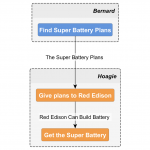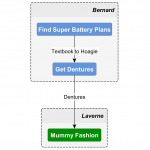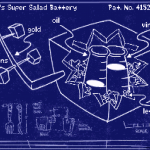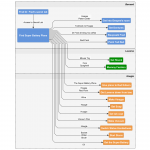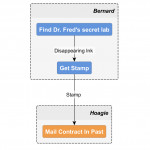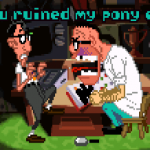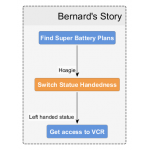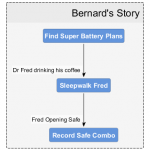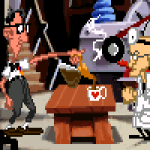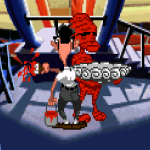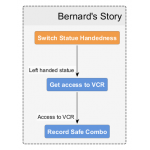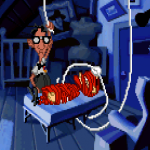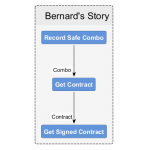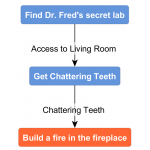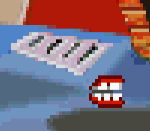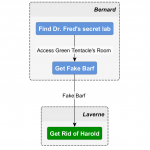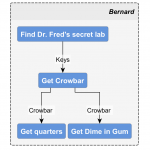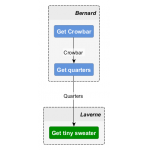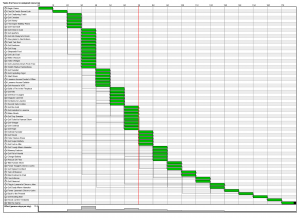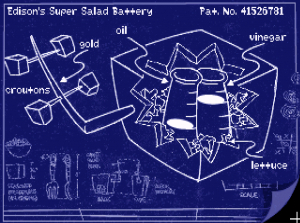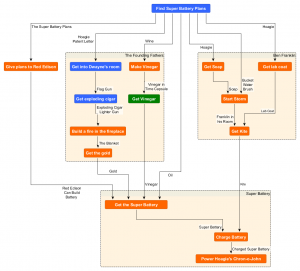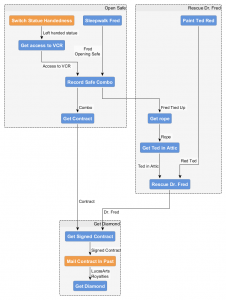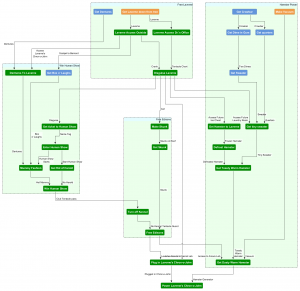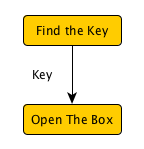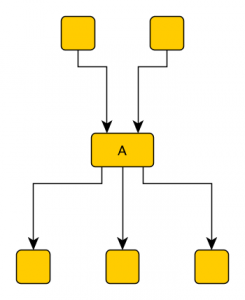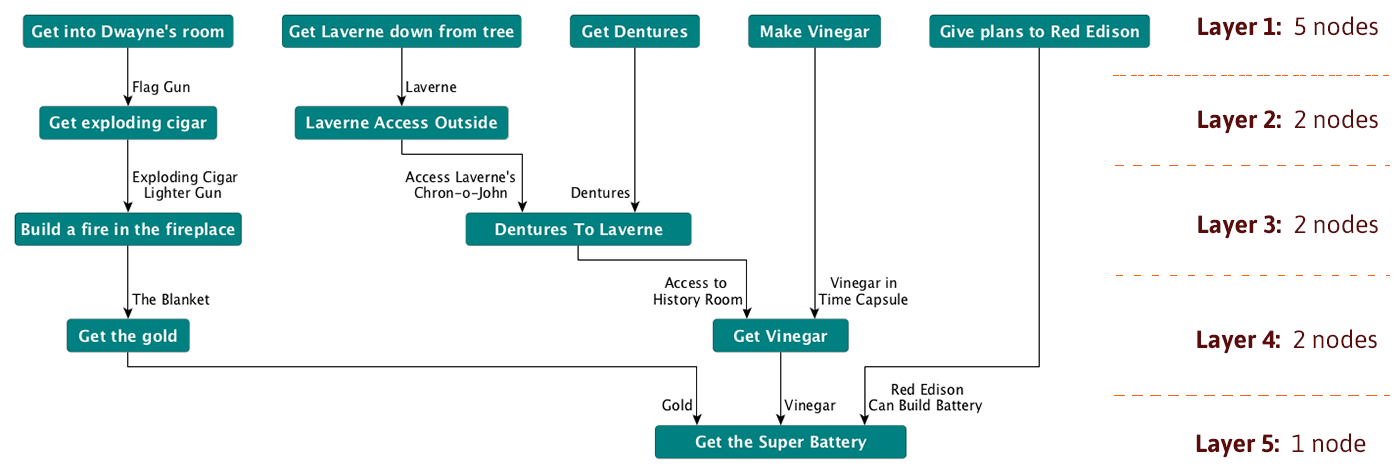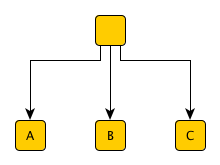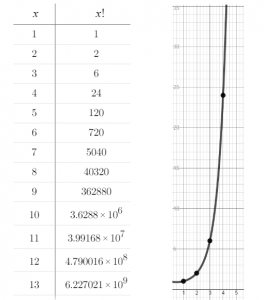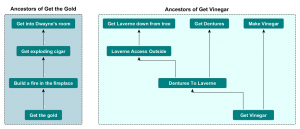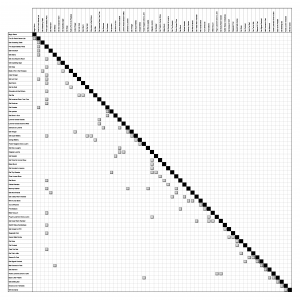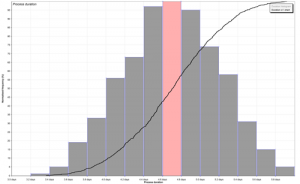This is part three of a three part series analyzing The Day of the Tentacle:
This post is an in-depth analysis of each puzzle in the game.
Note: This is a work in progress. Currently 18 of 63 puzzles have been broken down. Follow me on twitter (@brickshot) for updates.
Welcome to the third and final part of this series on The Day of the Tentacle. By this point you have hopefully read the introduction to Puzzle Dependency Graphs and seen them used in Part two to breakdown the framework of the game. This final post is a puzzle by puzzle wrap-up in which we’ll take a critical look at the game and apply some of Ron Gilbert’s rules for game design along the way.
Note that this is not a walk-through. There are plenty of those available (an excellent one is here). This is an attempt to analyze the game as a creative work in the way a film or novel might be. I will attempt to determine the quality of each puzzle (via a standard set of criteria) and see what part it plays in the game as a whole. My desire is to create a resource game developers seeking to learn from the game or just for fans who want to delve deeply into a classic game to see what makes it tick.
The Puzzles
By my count there are 63 puzzles in Day of the Tentacle. That does not include a few things which are not technically puzzles according to my definition but which will still feel like a puzzle to the player. Like realizing you can shut the door to the Sleeping Conventioneer’s room and get the keys out of it. I didn’t include it as a puzzle in my graph because it has no dependencies other than starting the game. You could certainly make an argument for including it in which case it would have an edge directly from the ‘Begin Game’ node.
Ron Gilbert’s Rules of Game Design
In addition to the puzzles it will be interesting to refer to Ron Gilbert’s rules for game design as laid out in his article Why Adventure Games Suck. He wrote that while designing Monkey Island (after Day of the Tentacle). There are 6 affirmative and 6 negative. We will look at instances of the affirmative in DOTT and note any cases where the negative rules were not followed.
Affirmative Rules:
|
Negative Rules:
|
Most of these are followed in Day of the Tentacle although not all.
Intro Segment
The linear introductory segment of the game has four puzzles if you include the not-really-a-puzzle of Boot Up the Game. While the player is not required to complete them all before moving on (see Highlight below) they are heavily encouraged to do so. These puzzles reveal critical story elements which almost all other puzzles rely on.
While providing back-story and plot these early puzzles also have the side effect of handing the player some early successes to boost their confidence.
The Meta-Game
At the beginning of the game the player is also engaging in a kind of meta-puzzle which goes on when playing any adventure game for the first time. This is the “What kind of game is this?” puzzle (for lack of a better name). Adventure games as a whole subscribe to a lot of similar conventions: focus on story, puzzle solving, inventory management, etc. But outside of genre conventions (and outside of the stories themselves) each individual adventure game has a very specific set of characteristics which inform the style of play. Some games allow your character to die (Beneath a Steel Sky, Kings Quest), while others don’t (Day Of The Tentacle). Some games reward exploration (The Secret of Monkey Island), while other games punish even the slightest risky move (Adventure). Some games require constant saves to protect against dead-ends (Zork Zero). Some have realtime action sequences (Space Quest) while many don’t. Knowing what kind of game is being played factors into how the game is played. Discovering these game-specific quirks is a real part of the player experience which I feel many designers don’t acknowledge or account for but which is critically important.
Day of the Tentacle does seem to take this opportunity to get the player acclimated to the type of game they are playing. So in these initial few sections of the game the player learns that dialogue is a big part of this game and exploring dialogue trees is as important as physical room exploration. While it’s not conclusive it appears that this is not the kind of game where arbitrary death is lurking around the corner and as such pre-emptive game saving is probably not necessary. While no difficult puzzles have come up yet it does feel like the puzzles are tied tightly in to the story.
This nascent trust-building time is very important in any game but especially in adventure games where the player needs to decide what “might” work in this world. The more consistently the game sticks to it’s own internal logic and rules the happier the player will be. Conversely when the game crosses its own implied boundaries and “throws a curve” the player more than often will feel betrayed.
Dependencies: None
New Rooms: Present-Day Lobby and Office
New items Available: Textbook, Dime, Bankbook, BooBoo-B-Gone, Flier
Other Rewards: Intro cutscene
Downstream Puzzles: Find the Secret Lab
The story begins. We learn that Purple Tentacle drank toxic sludge and has become fixated on taking over the world. In response Dr. Fred has captured both Purple and his harmless brother Green tentacle and plans to kill them both. Green tentacle sends a hamster to Bernard asking for help and Bernard determines to rescue him. He takes along his two roommates – Laverne and Hoagie. The game begins in the foyer of the Mansion with each of the three adventurers being assigned to an area of the house. Bernard takes the main floor and in case you skipped the intro he clearly states what needs to happen next: “We’ve got to find where Dr. Fred is holding the Tentacles.” If that wasn’t obvious enough he continues with “If I know Dr. Fred… He’s got the tentacles tied up in his secret lab. Question is, where is the secret lab?” Immediately we see Ron Gilbert following his own advice by making the current sub-goal very clear: Find the Secret Lab!
Right off the bat we’ve been rewarded with a huge entertaining animated cutscene just for booting the game. We’ve been cued in to the scenario and been pointed in the right direction by a very explicit line of dialogue.Bernard at this point has access to 2 rooms and 5 items. There is one real puzzle available at the moment: Where is Doctor Fred’s Secret Lab? Three other minor mysteries are also available if the player happens to notice them:
- What’s up with the dime and gum on the floor of the lobby?
- What’s up with the fake barf on the ceiling of the lobby?
- How do you open the safe? (Only if the picture in the office is opened)
The player’s emotional state at this point is one of enthusiasm brought on by the intro cut-scene and the clear goal they are being faced with. Their efforts are even more focused by the lack of mobility. There must be something in these two rooms which will help them get to the secret lab.
Dependencies: Boot up the Game
New Rooms: Entire Present-Day Mansion
New items Available: Disappearing Ink, Videotape, Hamster, Crank, Coffee, Decaf Coffee, Fork, Funnel
Downstream Puzzles: Find Super Battery Plans, The Chattering Teeth, The Crowbar, The Fake Barf, The Stamp
Other Rewards: Big cut-scene, lots of plot and the whole present day mansion to explore.
Once Bernard opens the door to the Grandfather clock he solves the first puzzle of the game and finds Dr. Fred’s Secret Lab. The reward is a large cutscene which gives us the main plot of the game: Keep purple tentacle from drinking the toxic sludge and taking over the world by turning off the Sludge-o-Matic yesterday via the time machine. This “simple” action is however immediately stymied when the time machine breaks and the three characters are strewn across the chronosphere.
Once Bernard is dropped off in the present day Dr Fred lays out explicitly the first subgoal (following the rule “Sub-goals need to be obvious”): Find the Super Battery Plans. We get a slew of new rooms to explore (all 16 rooms of the present day mansion) many new items to pick up and 5 new characters to interrogate.
At this point the next subgoal is very clear (Find The Super Battery Plans) but it is interesting to note that in this essentially linear portion of the game four other puzzles are already available as well: The Chattering Teeth, The Crowbar, The Fake Barf, The Stamp.
The Chattering Teeth, The Crowbar, The Fake Barf, The Stamp
These four puzzles require special mention because although the game strongly encourages you to find the Super Battery Plans at this point there are actually four other puzzles which can be solved now as well (and in any order).
Making these puzzles available gives the player some options while they wander around the mansion looking for the Super Battery Plans. In the event they get really stuck and solve all four of these side-puzzles first there are even a few more puzzles which open up due to their dependencies being satisfied. The game won’t really get started until the Super Battery is found however.
Dependencies: Find the Super Battery Plans
Dependencies Provide: The Super Battery Plans
New Rooms: None
New items Available: None
Downstream Puzzles: Get the Super Battery
Other Rewards: Tiny plot advancement
Again a very simple puzzle. You are free to explore the whole of the Mansion in the Past before solving this one but given the very direct instructions by Dr. Fred it’s pretty clear that you should try opening the grandfather clock and find out if Red Edison is down there. He is! What an amazing adventurer you are! Once we give the Patent Application to Red we are rewarded with a small advancement of the story. The Super Battery can be built from “Oil, Vinegar and Gold. Let me know if you come across any.”
The reward for solving this puzzle is really minor compared to the previous ones so it’s a good time to start talking about pace. The game up to this point has had a blazing pace. Each little puzzle resulted in large cutscenes explaining a lot of the story. We got a huge increase in the amount of available territory we could explore, new characters, items and dialogue. But now… what? A little tiny one line of dialogue. It seems like this should have killed the pace but in reality this is the first time we’ve had a moment to actually get down to the business of adventuring. We still have a very clear goal (Oil, Vinegar and Gold) and the world is our oyster.
Dependencies: Find the Super Battery Plans
Dependencies Provide: Access to Hoagie, Textbook to Hoagie via the Chron-o-John
New Rooms: None
New Items: The Dentures
Other Rewards: None
Downstream Puzzles: Mummy Fashion
OK why is a horse living in the Mansion? More importantly: Why do I still insist on looking for logic in this game when there clearly is none? Nowhere does a single other character mention this horse. And the horse itself just casually gives Hoagie shit about talking to horses. The real question is: Why does this feel totally normal and acceptable in this game? They clearly just take things so far that you give up trying to fit any logic to it. It works! I don’t know why or how but it works.
To look at the puzzle itself however we have to consider the hints. Hoagie repeatedly mentions the horse’s teeth so it’s pretty obvious we want them. But that suggests that we try to use the chattering teeth which quickly are denied. Mucking about with the glass of water gets you nothing. What on earth would point you to Bernard’s book? Not much I’m afraid. If Hoagie looks at the book he mentions that “it would work better than a sleeping pill” but that gets us thinking about the sleepwalking Dr Fred, not the horse. The only thing to suggest the horse might like a book read to it is that it is quite intelligent (and arrogant). Other than that thin clue this puzzle is sadly one of the try-everything-everywhere variety.
Bernard’s Story: Get a Diamond
Dependencies: Find The Secret Lab
Dependencies Provide: Access to Secret Lab (in the present)
New Rooms: Entire Past-Era Mansion
New items Available: Patent Application, Can Opener, Oil, Spaghetti, Bucket (Bucket Full of Water), Brush, Red Paint, Wine Bottle, Left Handed Hammer
Downstream Puzzles: Give plans to Red Edison, Get Laverne down from tree, Make Vinegar, Get into Dwayne’s room, Get the Super, Battery, Get Soap, Start Storm, Get lab coat, Get Dentures, Mummy Fashion, Get Skunk, Make Vacuum, Sleepwalk Fred, Switch Statue Handedness, Paint Ted Red
Other Rewards: Big cut-scene, access to Hoagie, information about the chron-o-johns
Is this even a puzzle? If I’m strict with my own definition then no. You don’t need to do anything but pick the plans up. It is a bit different however because the game has pretty clearly tried to steer the player away from finding them (at least immediately). Dr. Fred says that they are in the attic and wanders off that way. When followed up the stairs into the lobby he is seen wandering upstairs and if you follow him upstairs he goes off to the attic where you lose him. I feel this was done deliberately to get the player to explore the present-day mansion a bit before launching into another game-expanding cut-scene and opening up even more territory.
This is where the plot-heavy linear intro gives way to full-blown non-linear craziness. Looking at the Puzzle Dependency Graph you can see that there are 15 puzzles which are directly opened up by solving Find the Super Battery Plans. That being said the game heavily encourages you to take one more linear step: Give the Plans to Red Edison. This is encouraged by Doctor Fred’s direct instructions:
“I want you to pick up those plans you see in the Chron-O-John, Hoagie. Bring them to RED Edison. He’s my great, great, great, great, great, great, great, great, great, great grandfather. He’ll know what to do.”
If Doctor Fred wasn’t clear enough there are two more hints on how to proceed:
- The Dialogue Tree for the Sleeping Conventioneer includes Bernard musing about the Super Battery Plans: “I wonder where Dr. Fred could have put them? I’ll bet they’re someplace obvious.”
- Talking to Green Tentacle reveals this not-so-subtle hint: “Any of Fred’s plans would probably be in his office or the lab.” How much clearer can I say, “There’s always money in the banana stand!”
Side note – what about the croutons and lettuce needed for the Super Battery? The plans clearly show they are required! Does Red already have these ingredients lying around and so doesn’t need you to find them? Or did the puzzle originally include them and Lucas Arts forgot to change the graphic after removing it? Add this to the list of burning questions you will never have answered.
Dependencies: Find The Secret Lab
Dependencies Provide: Disappearing Ink
New Rooms: None
New Items: The Stamp
Other Rewards: None
Downstream Puzzles: Mail Contract in the Past
Weird Ed is, well, weird. This guy has calmed down a bit from Maniac Mansion but he certainly can be touchy. He does mention that those stamps are his whole life. Luckily Bernard is so socially inept that subtle social cues like that escape him and he’s more than willing to whip out his invisible ink for the lulz.
This is a good puzzle – nicely set up with two subtle hints in the dialogue and a big explosive payoff. I actually felt sorry for Weird Ed the first time. I mean he’s trying so hard to be good. The stamp isn’t used until much later in the game so it just kind of bounces around your inventory for a while depending on when you solve this. The one criticism I can make about this puzzle is that the invisible ink feels just arbitrarily thrown into Dwayne’s room. I mean he is a novelty item inventor but it’s just kind of there with no dialogue referencing it or anything.
As a side note… how did that hamster in Weird Ed’s room beat the kids back to the Mansion? They drove a car for fuck’s sake.
Dependencies: Find Super Battery Plans
Dependencies Provide: Hoagie
New Rooms: None
New Items: None
Other Rewards: Left Handed Statue
Downstream Puzzles: Get Access To VCR
OK so here’s the problem with this puzzle: There’s about a 50/50 chance you are going to encounter the solution before the problem. And if you “solve” the puzzle which you didn’t even realize exists you see a brief cut-scene of a room you may never have even visited before! This isn’t the worst example of this happening in Day of the Tentacle (see the Vacuum Puzzle) but it is rather glaring.
Here’s one way things could go: After finding the Secret Lab Bernard follows Dr. Fred up the stairs seeking the Super Battery Plans and going room to room exploring. When he happens upon Nurse Edna and being curious about the VCR and being stymied in all other things to do in the room and noting the awfully tempting rolly chair she’s sitting on he shoves Nurse Edna and she catches herself by the arm of the statue. Having no other way to get to the VCR Bernard just continues on his way thus setting up the puzzle as… well… a puzzle. Great! This is the “Lock before the Key” scenario.
The other just as likely scenario is this: After finding the Secret Lab Bernard follows Dr. Fred up the stairs seeking the Super Battery Plans. After getting one of the hints as to the whereabouts of the Super Battery Plans (see hints under Find The Super Battery Plans) he marches down there and picks them up leading to cut-scenes, Hoagie, etc. Now at any point Hoagie can grab the hammer and wander into the sculpting room. All it takes is some curiosity about that other hammer and BAM puzzle solved. Cut-scene to prove it as the statue in Nurse Edna’s room gets switched… but wait… we’ve never even been in Nurse Edna’s room! Dang and Blast this puzzle got all flipped around like a left handed hammer in the hands of a right handed sculptor. Egh sorry. It’s late.
The point is – a better puzzle would not let us solve it before we realize it even exists. I must say the humor of a left-handed hammer is points in this puzzle’s favor though – in general this game gets by on personality in times of crisis and so it is here.
Dependencies: Find Super Battery Plans
Dependencies Provide: Dr. Fred Drinking His Coffee
New Rooms: None
New Items: None
Other Rewards: Dr. Fred Opening Safe
Downstream Puzzles: Record Safe Combo
By talking to Dr. Fred Bernard can discover the hilarious story behind the family’s failed finances. This dialogue tree includes one of the best lines of the game (and one of the best lampshades ever):
Let’s go get the contract out of the safe and sign it!
DR FRED
I forgot the combination!
BERNARD
But that’s … that’s so STUPID, Doctor Fred!
Once clued in to the fact that Dr. Fred drinks coffee to stay awake it’s pretty clear what needs to be done. Even without this hint the coffee mug is blazingly obvious as a target for messing with – once you realize you can’t pick it up you’ll certainly try putting various types of coffee in it. If you do manage to solve the puzzle without hearing the back-story first you’ll end up with some unexplained dialogue later on (Bernard makes reference to “Dr. Fred’s contract” for example) but this is fairly unlikely since Nurse Edna also explains the whole story as well as a backup. In any event no matter how you get there the payoff for the puzzle is quite satisfying as it turns Dr. Fred into a sleepwalking zombie who opens and closes the safe in the office. Now you can just go in there and grab the contract while it’s open! Wait you can’t do that because… reasons. See Record Safe Combo for some notes on this state of affairs. Spoiler alert: It’s annoying.
There are some red-herrings around the coffee which may have been added to try to make this puzzle more difficult. For example both regular and decaf coffee comes up in Hoagie’s conversation with John Hancock and when Hoagie looks at the Kite Plans in the mirror he sees a coffee stain on there as well. Obviously exploring using the coffee in the past is stymied by the fact that you can’t get it through the Chron-o-John so ultimately this puzzle remains quite easy.
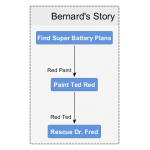 Dependencies: Find Super Battery Plans
Dependencies: Find Super Battery Plans
Dependencies Provide: Red Paint
New Rooms: None
New Items: None
Other Rewards: Red Ted
Downstream Puzzles: Rescue Dr. Fred
One of two puzzles in the game which are solved with the red paint, this one is hinted at visually by the fact that once Dr. Fred gets tied up in red tape he does look an awful lot like Ted the Mummy. While it’s possible to paint Ted Red very early in the game (immediately after finding the Super Battery Plans) there is really no reason you would try it until you see Dr. Fred tied up after being snatched by the IRS agents. This puzzle is the easiest part of the Rescue Dr. Fred puzzle sequence.
Dependencies: Switch Statue Handedness
Dependencies Provide: Left handed statue
New Rooms: None
New Items: None
Other Rewards: None
Downstream Puzzles: Record Safe Combo
Creepy-ass Nurse Edna! Trying to put the moves on teen-aged boys and generally being a freak gives the player no remorse when they kick her down the steps. Of course it’s mostly those tempting wheels on that rolly chair which hint that pushing her might be a good idea…
As mentioned in Switch Statue Handedness it’s pretty easy to stumble on the solution to that puzzle without really understanding how you did it (via switching the statues before trying to push Edna). This part of the puzzle is really well done however. The player is dying to get their hands on all that… technology. And Edna’s constant admonition to “Get away from that.” makes you just want to shove that crazy old bat out the door! The fact that she actually ends up completely disappearing from the mansion is a bit odd. There’s not even an Edna shaped hole in the front door. This puzzle and the Enter Human Show puzzle both involve shoving someone down the steps so whichever one you solve first acts as a hint for the other. Clever! And quite satisfying.
Note: Bernard’s quote about pushing old-ladies down the steps is probably one of the most quoted from the game.
Dependencies: Get Access to VCR, Sleepwalk Fred
Dependencies Provide: Access to VCR, Fred Opening Safe
New Rooms: None
New Items: None
Other Rewards: None
Downstream Puzzles: Get Rope, Get Contract
Maybe it’s because I love technology but this is one of my favorite puzzles in the game. It’s quite simple to solve once you have the prerequisites but the fact that you can load up the VCR with a tape and then record, rewind, playback and fiddle with the speed settings is very satisfying. Does anyone have a degree in VCR repair? Can you please tell me it’s actually possible to playback a tape recorded at SP in EP and it will be in slow motion. My brain says no but I want to believe.
To step back a minute though… this scenario doesn’t make a lot of sense to me. Dr. Fred has forgotten the combination to the safe but he knows that the contract is in there and he also knows that it doesn’t matter anyway because he didn’t sign it in time to get the royalty money. This is all explained to Bernard by Dr. Fred. So what is he freaking out about when he opens the safe? Nurse Edna says “something about what’s in there really scares him”… but what? Maybe I’m missing something obvious here but it seems like he already knows exactly what’s in there and it shouldn’t surprise or scare him at all. I guess we can chalk it up to sleepwalking craziness but it does feel like they backed the plot into this one after deciding how you would solve it first.
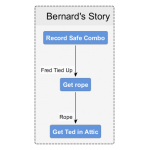 Dependencies: Record Safe Combo
Dependencies: Record Safe Combo
Dependencies Provide: Fred Tied Up
New Rooms: None
New Items: Rope
Other Rewards: None
Downstream Puzzles: Get Ted in Attic
Fuck me how did this get in here. This isn’t a puzzle! Once you find Fred in the attic you can just pick the rope up. Well shit. I already included it in a raft of graphs and charts and I have no interest in going back to fix it so I guess it makes the cut. Luckily I’m just analyzing a video game, not doing rocket science. Although in the words of my genius rocket-scientist friend Wayne: “Even rocket science isn’t rocket science”. Wise words.
Dependencies: Record Safe Combo
Dependencies Provide: Safe Combo
New Rooms: None
New Items: Rope
Other Rewards: None
Downstream Puzzles: Get Signed Contract
This is the last phase of the excellent group of puzzles needed to open the safe. Outside of some confusing character motivation (see Sleepwalk Fred) this whole story-line is really entertaining. I like how once you have recorded the combination on the VCR you aren’t expected to write it down and then manually enter it via some clumsy user interface. Having Bernard just take over because he knows the combo now is much more pleasing and cuts right to the chase.
Interesting note: If you try to open the safe during the end-game (which is the day before the main game) you get this cautionary bit of dialogue:
We need to leave the contract in there so I can get it tomorrow and send it to Hoagie two hundred years ago.
They thought of everything! Too bad they didn’t… see You can pick up the help wanted sign.
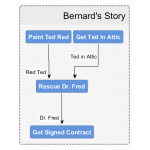 Dependencies: Get Ted In Attic, Paint Ted Red
Dependencies: Get Ted In Attic, Paint Ted Red
Dependencies Provide: Ted in Attic, Red Ted
New Rooms: None
New Items: Rope
Other Rewards: Dr. Fred
Downstream Puzzles: Get Signed Contract
You have to use ted with dr fred. As confusing as the puzzle with the mattress. Also when Bernard is on the roof and you use rope he says he’s not going to make that mistake again and he moves to the other side. But what mistake is he talking about? I guess when he fell off the roof.
Hoagie’s Story: Power Hoagie’s Chron-o-John
Dependencies: Find The Secret Lab
Dependencies Provide: Access to Living Room
New Rooms: None
New Items: The Chattering Teeth
Downstream Puzzles: Build a Fire
Other Rewards: None
How to pick up the Chattering Teeth? This counts as a puzzle because you can’t just pick them up – you must take a different set of actions which results in getting the teeth. The solution is available in the same room – open the grate and chase the teeth in there. Doing so nets you the reward you might expect: the teeth and nothing else. This is unremarkable except that it’s an example of a Backward Puzzle which Ron Gilbert has admonished us against.
In fact there are many examples in DOTT of this kind of thing – inventory items with no current applicability. After finding Dr. Fred’s Secret Lab the player has access to the whole present-day mansion. Exploring it methodically and picking up every possible thing will net 13 items in their inventory and each one is a “key before the lock”.
Whether this negatively impacts the gameplay is debatable. The inventory in this game is not capped and so it seems there is no harm in just making lots of items available for easy pickup. It makes the player feel like they are making progress and doing well. “Boy I’m finding all kinds of useful(?) stuff!” On the other hand for each new item in their inventory the player may (at least mentally) start trying to apply it to every available situation. “I wonder if Edna would like a pair of Chattering Teeth? No? Maybe Weird Ed?” After a while the exponential growth of potential items and uses and places for them to go grows out of hand and the player may get a sinking feeling that they will never figure it all out.
Laverne’s Story: Power Laverne’s Chron-o-John
Dependencies: Find The Secret Lab
Dependencies Provide: Access to the Tentacles’ Room
New Rooms: None
New Items: The Fake Barf
Other Rewards: None
Downstream Puzzles: Get Rid of Harold
Ah the fake barf. So tantalizing. So elusive. So… insane. Why is it up there? Apparently the novelty salesman bash from the night before got a little out of hand. I’ll accept it. How to get it down? Well luckily this puzzle introduces the Day of the Tentacle patented quick-cutaway cut-scene which gives you a nice hint while you’re putting your grubby hands all over everything in the tentacle’s bedroom. Turning on the stereo cuts to a brief view of downstairs and you see the barf aaaaaaalmost fall off the ceiling. What a tease. But this does two things: First it lets you know that something in another room has changed. This is the “No Unconnected Events” rule in action. In some games (*cough* Zork *cough*) your actions have unseen consequences all around the world. This feels totally arbitrary and sometimes when you solve a puzzle you might not even realize that you’ve solved it (or get the satisfaction of doing so). Now Day of the Tentacle isn’t totally innocent of this crime even while using this quick-cutaway device (see Switch Statue Handedness) but it does solve the problem in almost every case. Second (bet you thought I forgot) this cut-away gives you a much needed hint on how to actually get the barf down. You now know that you’re right on top of it (which is not apparent from the room layout) and that loud noises can affect it. This turns what would otherwise be a pixel-hunting/try-everything-once kind of puzzle into something that feels motivated and fair.
Dependencies: Find The Secret Lab
Dependencies Provide: Keys
New Rooms: None
New Items: The Crowbar
Other Rewards: None
Downstream Puzzles: Get Dime From Gum, Get The Quarters
This puzzle could arguably be broken into two parts, the first being: Get the Keys. I left that out since the keys are technically just hanging on that door with the puzzle being that you have to realize you can close doors once you go into rooms. Once you have the keys you go hand them to the car thief and get his crowbar.
This puzzle always struck me as a little bizarre. The car thief is totally outside the plot and just happens to spend his entire night working on the only car outside the mansion. And why is he trying to break into the trunk of the car? They have a line of dialogue attempting to lampshade this but it makes no sense. Wouldn’t he just break a window instead of perpetually trying to wiggle his crowbar into the trunk? (There’s a dirty joke in here somewhere). Obviously it’s because then he wouldn’t be there to trade you the crowbar but it feels a bit random. Once you get the crowbar you can get the dime from the gum in the lobby or attack the vending machine for quarters.
Dependencies: Get the Crowbar
Dependencies Provide: Crowbar
New Rooms: None
New Items: The Quarters
Other Rewards: None
Downstream Puzzles: Get Tiny Sweater
To be continued…
